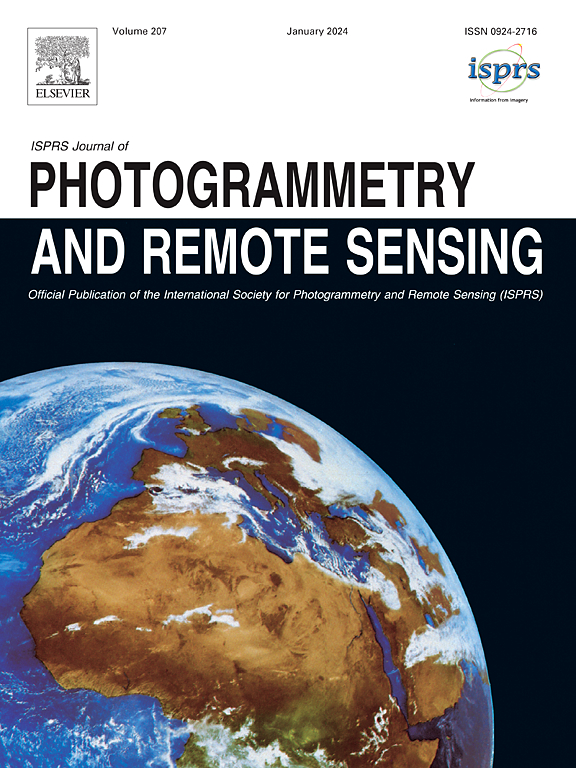采矿挖掘均匀网格生成的三维点云正则化方法
IF 10.6
1区 地球科学
Q1 GEOGRAPHY, PHYSICAL
ISPRS Journal of Photogrammetry and Remote Sensing
Pub Date : 2024-11-09
DOI:10.1016/j.isprsjprs.2024.10.024
引用次数: 0
摘要
矿山挖掘系统通常长达数十公里,其几何形状在小范围(墙壁的粗糙度和形状)和大范围(隧道、转弯和交叉口的宽度不同)都各不相同。在这篇文章中,作者探讨了分析大型采矿结构激光扫描数据的问题,这些数据可用于各种用途,重点是通风模拟。由于测量数据的质量问题(点云密度不同、样本缺失、视场中的障碍物造成的孔洞、测量噪音),这就产生了需要对所获数据进行多阶段处理的问题。作者提出了一种稳健的方法来处理采矿系统的单一分段。该方法的重点是获取可用于气流计算流体动力学(CFD)分析的点云,并尽量减少对生成的网格模型进行额外手动修正的需要。这就要求点云具有均匀分布的点并减少噪音(同时去除内部物体),同时保持扫描隧道的独特几何特性和形状。所提出的方法使用了在测量过程中或通过文章中解释的骨架化过程获得的挖掘轨迹。在垂直于轨迹的平面上获得的横截面经过处理,以实现点分布的均衡化,去除测量噪声、点云中的孔洞和挖掘物内部的物体。通过比较处理后的云和原始云,并在 CFD 环境中进行测试,验证了所提算法的效果。事实证明,该算法在提高所获网格的偏斜率和几何映射精度(在云与网格的比较中,标准偏差低于 5 厘米)方面非常有效。本文章由计算机程序翻译,如有差异,请以英文原文为准。
3D point cloud regularization method for uniform mesh generation of mining excavations
Mine excavation systems are usually dozens of kilometers long with varying geometry on a small scale (roughness and shape of the walls) and on a large scale (varying widths of the tunnels, turns, and crossings). In this article, the authors address the problem of analyzing laser scanning data from large mining structures that can be used for various purposes, with focus on ventilation simulations. Together with the quality of the measurement data (diverse point-cloud density, missing samples, holes induced by obstructions in the field of view, measurement noise), this creates problems that require multi-stage processing of the obtained data. The authors propose a robust methodology to process a single segmented section of the mining system. The presented approach focuses on obtaining a point cloud ready for application in the computational fluid dynamics (CFD) analysis of airflow with minimal need for additional manual corrections on the generated mesh model. This requires the point cloud to have evenly distributed points and reduced noise (together with removal of objects inside) while keeping the unique geometrical properties and shape of the scanned tunnels. Proposed methodology uses trajectory of the excavation either obtained during the measurements or by skeletonization process explained in the article. Cross-sections obtained on planes perpendicular to the trajectory are processed towards the equalization of point distribution, removing measurement noise, holes in the point cloud and objects inside the excavation. The effects of the proposed algorithm are validated by comparing the processed cloud with the original cloud and testing within the CFD environment. The algorithm proved high effectiveness in improving skewness rate of the obtained mesh and geometry mapping accuracy (standard deviation below 5 centimeters in cloud-to-mesh comparison).
求助全文
通过发布文献求助,成功后即可免费获取论文全文。
去求助
来源期刊

ISPRS Journal of Photogrammetry and Remote Sensing
工程技术-成像科学与照相技术
CiteScore
21.00
自引率
6.30%
发文量
273
审稿时长
40 days
期刊介绍:
The ISPRS Journal of Photogrammetry and Remote Sensing (P&RS) serves as the official journal of the International Society for Photogrammetry and Remote Sensing (ISPRS). It acts as a platform for scientists and professionals worldwide who are involved in various disciplines that utilize photogrammetry, remote sensing, spatial information systems, computer vision, and related fields. The journal aims to facilitate communication and dissemination of advancements in these disciplines, while also acting as a comprehensive source of reference and archive.
P&RS endeavors to publish high-quality, peer-reviewed research papers that are preferably original and have not been published before. These papers can cover scientific/research, technological development, or application/practical aspects. Additionally, the journal welcomes papers that are based on presentations from ISPRS meetings, as long as they are considered significant contributions to the aforementioned fields.
In particular, P&RS encourages the submission of papers that are of broad scientific interest, showcase innovative applications (especially in emerging fields), have an interdisciplinary focus, discuss topics that have received limited attention in P&RS or related journals, or explore new directions in scientific or professional realms. It is preferred that theoretical papers include practical applications, while papers focusing on systems and applications should include a theoretical background.
 求助内容:
求助内容: 应助结果提醒方式:
应助结果提醒方式:


